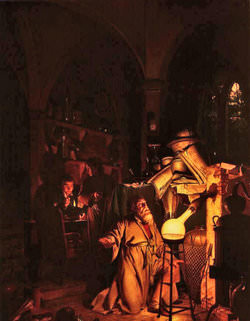International Journal for Philosophy of Chemistry, Vol. 9:2 (2003)
Abstract
This paper explores major trends in visualization of medieval theories of natural and artificial transformation of substances in relation to their philosophical and theological bases. The function of pictorial forms is ana- lyzed in terms of the prevailing conceptions of science and methods of trans- mitting knowledge. The documents under examination date from the thirteenth to the fifteenth century. In these, pictorial representations include lists and tables, geometrical figures, depictions of furnaces and apparatus, and figurative elements mainly from the vegetable and animal realms. An effort is made to trace the earliest evidence of these differing pictorial types.
Visualization in medieval alchemy is a relatively late phenomenon. Documents dating from the introduction of alchemy into the Latin West around 1140 up to the mid-thirteenth century are almost devoid of pictorial elements. During the next century and a half, the primary mode of representation remained linguistic and propositional; pictorial forms developed neither rapidly nor in any continuous way. This state of affairs changed in the early fifteenth century when illustrations no longer merely punctuated alchemical texts but were organized into whole series and into synthetic pictorial repre- sentations of the principles governing the discipline. The rapidly growing number of illustrations made texts recede to the point where they were re- duced to picture labels, as is the case with the Scrowle by the very successful alchemist George Ripley (d. about 1490). The Silent Book (Mutus Liber, La Rochelle, 1677) is entirely composed of pictures. However, medieval alchem- ical literature was not monolithic. Differing literary genres and types of illustrations coexisted, and texts dealing with the transformation of metals and other substances were indebted to diverging philosophical traditions.
Visualization in Medieval Alchemy
Barbara Obrist
International Journal for Philosophy of Chemistry, Vol. 9:2 (2003)
Abstract
This paper explores major trends in visualization of medieval theories of natural and artificial transformation of substances in relation to their philosophical and theological bases. The function of pictorial forms is ana- lyzed in terms of the prevailing conceptions of science and methods of trans- mitting knowledge. The documents under examination date from the thirteenth to the fifteenth century. In these, pictorial representations include lists and tables, geometrical figures, depictions of furnaces and apparatus, and figurative elements mainly from the vegetable and animal realms. An effort is made to trace the earliest evidence of these differing pictorial types.
Visualization in medieval alchemy is a relatively late phenomenon. Documents dating from the introduction of alchemy into the Latin West around 1140 up to the mid-thirteenth century are almost devoid of pictorial elements. During the next century and a half, the primary mode of representation remained linguistic and propositional; pictorial forms developed neither rapidly nor in any continuous way. This state of affairs changed in the early fifteenth century when illustrations no longer merely punctuated alchemical texts but were organized into whole series and into synthetic pictorial repre- sentations of the principles governing the discipline. The rapidly growing number of illustrations made texts recede to the point where they were re- duced to picture labels, as is the case with the Scrowle by the very successful alchemist George Ripley (d. about 1490). The Silent Book (Mutus Liber, La Rochelle, 1677) is entirely composed of pictures. However, medieval alchem- ical literature was not monolithic. Differing literary genres and types of illustrations coexisted, and texts dealing with the transformation of metals and other substances were indebted to diverging philosophical traditions.
Click here to read this article from the International Journal for Philosophy of Chemistry
Subscribe to Medievalverse
Related Posts